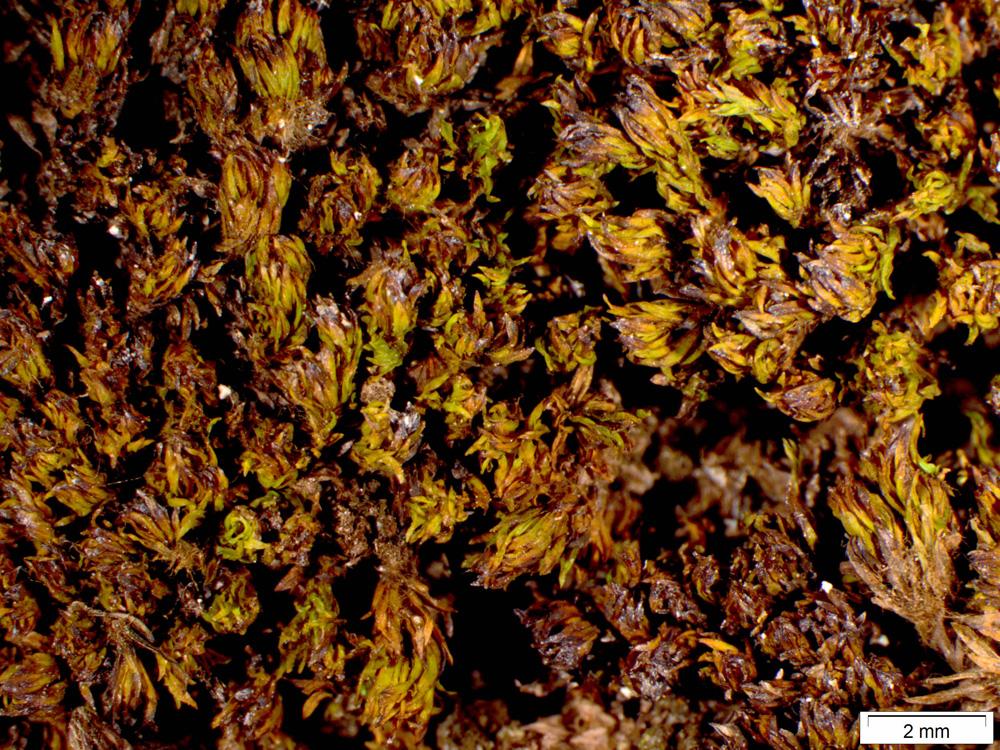
Consortium of Bryophyte Herbaria
- building a Consortium of Bryophytes and Lichens as keystones of cryptobiotic communities -
|
Family: Pottiaceae |
Plants: forming a thin or thick turf, green to greenish yellow or brown distally, blackish or weakly iridescent to metallic tan or yellow-brown proximally. Stems: to 4 cm, rounded-pentagonal in transverse section, hyalodermis absent, sclerodermis absent, central strand absent; axillary hairs 3–5 cells in length, proximal cell usually brownish. : Cauline leaves often crowded, incurved to spreading, contorted, carinate, occasionally with undulating margins when dry, spreading when moist; lingulate to ligulate or oblanceolate, widest at mid leaf or beyond, adaxial surface narrowly and deeply grooved along costa or broadly channeled, to 2.5 mm; base scarcely differentiated in shape to long-elliptic, occasionally medially constricted, proximal margins occasionally slightly decurrent; distal margins plane or somewhat recurved proximally, entire to minutely crenulate or denticulate distally, often bordered by a few rows of thicker walled cells distally; apex broadly acute or obtuse, often with a broad apiculus, occasionally rounded; costa slender, percurrent or ending 2–8 cells before the apex, occasionally excurrent as a short mucro, adaxial outgrowths absent, adaxial cells quadrate to rectangular, in 2–4 rows; transverse section semicircular to round, adaxial epidermis absent or present, adaxial stereid band absent, guide cells 2(–4) in 1 layer, hydroid strand absent, abaxial stereid band present, rounded in sectional shape, abaxial epidermis present, usually very distinct; proximal cells differentiated across leaf, extending higher medially, rectangular, occasionally inflated, scarcely wider than distal cells to inflated, 2–3:1, walls of proximal cells hyaline or deep brown; distal medial cells rounded quadrate to hexagonal or short-rectangular, ca. 8–14 µm, often heterogeneous in size, 1(–2):1, 1-stratose; papillae usually lacking, occasionally low-verrucose, cell walls thin to evenly thickened, thicker near margins, flat or somewhat bulging on adaxial surface. : Specialized asexual reproduction rare, on stalks from the stem, greenish brown, clavate to ellipsoid or filamentous and branching, ca. 12 µm, of 2 or more rounded cells. Sexual: condition dioicous. Perichaetia: terminal, interior leaves little differentiated. [Seta 2–6 mm. Capsule: stegocarpous, theca shortly elliptic to cylindric, macrostomous, 0.6–2.2 mm, annulus weakly differentiated or of 1–4 rows of vesiculose cells, deciduous in fragments; operculum conic-rostrate, erect or oblique; peristome teeth absent. Calyptra: cucullate. Spores: 8–13 µm.] KOH distal laminal color reaction yellow to yellowish orange. North America, Mexico, Central America, South America, Europe, Asia, c Africa, Pacific Islands (Hawaii). Species 3 (2 in the flora). Scopelophila is a small genus (R. H. Zander 1993) of †copper mosses† (see reviews by A. J. Shaw and L. E. Anderson 1988; Shaw 1993) associated with mineralized soils. Crumia is similar but is quickly distinguished by its stem central strand, intramarginal laminal border, and distal laminal cells usually distinctly papillose. |
Powered by Symbiota.





